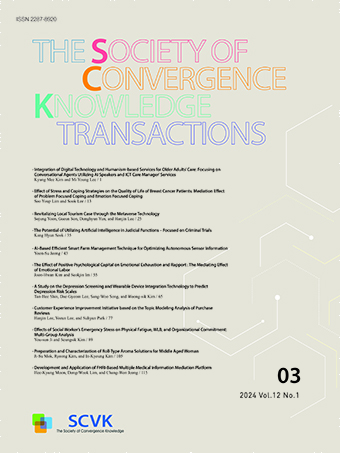Research Article
Abstract
References
Information
최근 춥고 열악한 지역에서 비전통에너지를 비롯한 오일 및 가스의 개발이 점증하는 추세를 보이고 있는데, 이러한 지역은 생산수의 확보가 어려워 재이용하는 방법이 필요하다. 생산수의 재이용에 있어서 환경오염이나 기계장치의 성능에 영향을 미치는 염분이나 산성도, 이온물질 등을 기준치 이하로 제거한다. 본 논문에서는 생산수에 포함된 미세오일을 효과적으로 제거하는 성능실험을 위해 180 BPD (bbl/day)의 처리용량을 가지는 생산수처리시스템을 제작하였다. 이 장치는 미세기포 생성을 위한 포화기, 이덕터, 순환펌프, 가스 탱크 등을 구비하도록 하였다. 이러한 실험장치를 이용하여 운전조건에 따른 미세기포 생성특성과 생산수의 오일의 농도에 따른 오일 제거특성을 실험적으로 평가하였다. 미세기포 생성실험을 통해 본 제안시스템의 경우에 압력, 가스량, 순환수량에 따라 미세기포의 생성특성을 조절할 수 있었다. 또한 미세기포의 생성형태에 따라 오일 제거효율에 영향을 미치고 있음을 알 수 있었다. 특히, 질소가스량과 순환수량이 미세기포 생성에 가장 큰 영향을 미치고, Cell의 구성에 따라 오일제거성능을 97.1%까지 평가할 수 있었다.
Recently, the development of oil and gas, including unconventional energy, has been increasing in cold and harsh areas, and it is difficult to secure produced water in these areas, and a method of reuse is needed. In the reuse of the produced water, salts, acidity, ionic substances, etc., which affect the environmental pollution and the performance of machinery are removed below the standard value. In this paper, a produced water treatment system with a processing capacity of 180 BPD (bbl / day) was fabricated for the performance test to effectively remove fine oil contained in the produced water. The device is equipped with a saturator, an eductor, a circulation pump, a gas tank, etc. for generating micro-bubbles. Using these experimental devices, the microbubble formation according to the operating conditions and the oil removal characteristics according to the oil concentration of the produced water were evaluated experimentally. In the case of the proposed system through the micro-bubble generation test, it was possible to adjust the micro-bubble generation characteristics according to the pressure, the amount of gas, and the amount of circulating water. In addition, it can be seen that it affects the oil removal efficiency according to the formation form of the fine bubbles. In particular, the amount of nitrogen gas and the amount of circulating water had the greatest influence on the generation of micro-bubbles, and the oil removal performance could be evaluated by 97.1% depending on the cell composition.
- 국토교통부, 극한지 자원화 플랜트 기술개발사업 기획보고서, 2018.
- US Environmental Protection Agency (EPA), Clean Water Act (CWA), 2016.
- SIEMENS, https://w3.siemens.com
- MathenaTM, https://www.global.weir
- 이우호 외, 유수분리기 baffle 위치변화에 따른 유동특성에 관한 연구, 2016 한국유체기계학회 동계 학술대회 논문집, 2016.
- Joung-Won Kim, Wooho Lee amd Inju Hwang, Investigation of Bubble effects on the oil-water separation by induced gas flotation, Proceedings of ICCHM2T, 2017.
- Publisher :The Society of Convergence Knowledge
- Publisher(Ko) :융복합지식학회
- Journal Title :The Society of Convergence Knowledge Transactions
- Journal Title(Ko) :융복합지식학회논문지
- Volume : 7
- No :4
- Pages :79-85
- DOI :https://doi.org/10.22716/sckt.2019.7.4.053




 The Society of Convergence Knowledge Transactions
The Society of Convergence Knowledge Transactions







